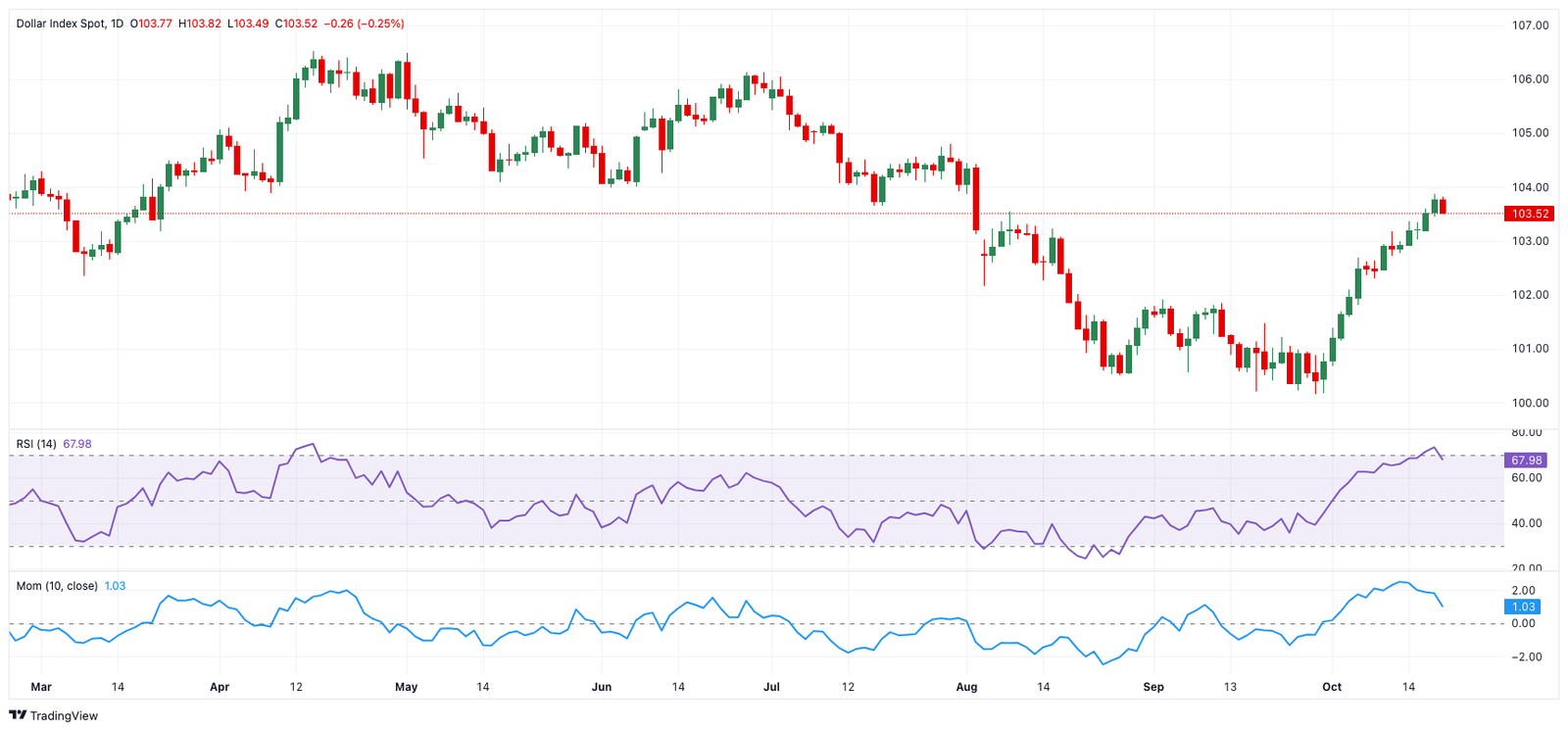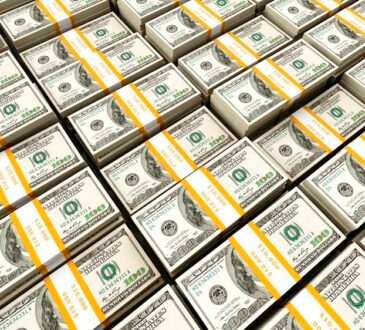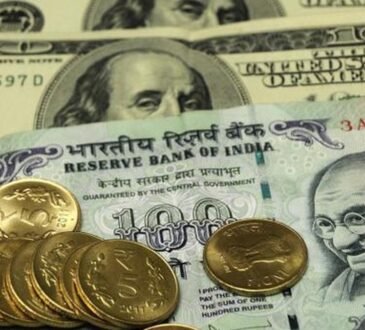- The US Dollar Index clinches its third weekly gain in a row.
- Fed’s 25-basis-point rate cut in November looks likely.
- Geopolitics, firm US data, and politics prop up the US Dollar.
The US Dollar (USD) had another strong performance these past few days, extending its gains for the third consecutive week, including a test of the critical 200-day SMA around 103.80 when tracked by the US Dollar Index (DXY) for the first time since the summer.
It is worth recalling that the Greenback embarked on the current rally soon after investors digested the Federal Reserve’s (Fed) unexpected half-point rate cut on September 18. It has been underpinned since then by a resilient US economy, a gradual cooling in the labour market, and growing speculation of a 25-basis-point (bps) rate cut next month instead of a 50 bps cut.
Looking ahead, the Dollar should shift its outlook to a more constructive one on a clear breakout of the always-relevant 200-day Simple Moving Average (SMA) on Friday at 103.77.
A 25 bps rate cut gains traction amid US economic resilience
After the unexpected 50-basis-point rate cut in September, market participants are now closely watching the performance of the US economy to assess the likelihood of additional cuts. This heightened focus mirrors the Federal Reserve’s shift toward labour market conditions, though core inflation — excluding food and energy — has proven more persistent than initially anticipated.
On September 30, Fed Chair Jerome Powell remarked that the US economy seems to be on course for continued inflation declines, potentially allowing the central bank to lower its benchmark interest rate further and move toward a neutral level that supports economic growth. He also suggested that future rate cuts of 25 basis points per meeting could become the standard approach.
Fed officials offered a variety of perspectives on future interest rate cuts throughout the week. While many policymakers appear to favour a quarter-point reduction next month, not all share this view.
On that, Neel Kashkari, President of the Federal Reserve Bank of Minneapolis, indicated that further rate cuts are likely as the Fed moves closer to its 2% inflation target. His colleague, San Francisco Fed President Mary Daly, mentioned that if inflation decreases as anticipated, “one or two” rate cuts this year could be a sensible course for the central bank, though she stressed that future decisions would be data-dependent, allowing flexibility to adjust rates accordingly. Raphael Bostic, President of the Atlanta Federal Reserve, argued that he had accounted for just one additional 25-basis-point rate cut for this year in his projections. However, he clarified that his forecast isn’t fixed, emphasising that he would adjust based on new economic data, particularly around inflation and employment, adding that he was “keeping [his] options open.”
The CME Group’s FedWatch Tool now estimates a 92% likelihood of a 25-basis-point rate cut at the November 7 meeting, up sharply from the 62% probability projected just a month ago.
As the Fed shifts its focus from closely monitoring inflation to paying greater attention to the labour market, the performance of the broader economy has become a crucial factor in shaping future monetary policy decisions.
In September, Nonfarm Payrolls (NFP) data showed the addition of 254K jobs, with the Unemployment Rate edging down to 4.1%. The ADP report also exceeded expectations last month, while weekly jobless claims continue to support the view of a strong labour market.
Despite a slight slowdown in industrial sector activity, it remains remarkably resilient, and the services sector continues to show robust growth.
Recent GDP figures further support this outlook, reinforcing the belief that the economy is not heading for a recession — neither a soft landing nor a hard one appears imminent.
When comparing the current performance of the US economy to its G10 counterparts, it’s clear why the US Dollar could continue to strengthen against its rivals over the medium to long term.
The interest rate puzzle: Global perspectives
The Eurozone, Japan, Switzerland and the United Kingdom are grappling with increasing deflationary pressure, with economic activity becoming increasingly unpredictable.
In response, the European Central Bank (ECB) cut interest rates by 25 basis points on October 17, though officials refrained from providing additional details or forward guidance on the central bank’s future actions.
Similarly, the Swiss National Bank (SNB) also reduced rates by 25 basis points on September 26.
The Bank of England (BoE) recently held its policy rate steady at 5.00%, citing persistent inflation, elevated service sector prices, robust consumer spending, and stable GDP as reasons for the decision. However, recent comments from Governor Andrew Bailey suggested the BoE could adopt a more aggressive approach to rate cuts in the future.
Meanwhile, the Reserve Bank of Australia (RBA) kept rates unchanged at its September 24 meeting but maintained a hawkish tone in subsequent statements, with analysts predicting potential rate cuts by late 2024 or early 2025.
The Bank of Japan (BoJ) maintained its dovish stance at its September 20 meeting, with market expectations pointing to only a modest 25 bps rate hike over the next 12 months.
The delicate dance of politics and economic strategy
As the November 5 election nears, recent polls still indicate a close contest between Vice President Kamala Harris, the Democratic presidential nominee, and Republican challenger, former President Donald Trump.
Looking at the potential scenarios, a Trump victory could result in a reintroduction of tariffs, potentially disrupting or reversing the current disinflationary trend in the US economy, which might in turn prompt the Fed to interrupt its easing cycle.
Conversely, a Harris administration may favour higher taxes and could push for more accommodative monetary policy from the Fed, particularly if signs of an economic slowdown begin to surface.
In any case, it appears that fiscal policy will remain a central focus of the debate, regardless of who becomes the next US President.
What’s up next week?
Next week provides new insights into this month’s business activity with the release of advanced Manufacturing and Services PMIs. Alongside these reports, Durable Goods Orders and the Michigan Consumer Sentiment gauge will be published, as well as the Fed’s Beige Book.
Meanwhile, activity around speeches from Fed officials is expected to be minimal.
Techs on the US Dollar Index
Amidst the ongoing rally in the US Dollar Index (DXY), the next key target is the October high of 103.87 (set on October 17), a level bolstered by the 200-day Simple Moving Average (SMA). A sustained move above this area could pave the way for a push toward the weekly high of 104.79, recorded on July 30.
On the flip side, while downward pressure on the DXY has subsided in recent days, strong support remains at the year-to-date low of 100.15, set on September 27. Should selling pressure reappear and the DXY breaches this level, it may retest the psychological 100.00 milestone, potentially leading to a drop to the 2023 low of 99.57 from July 14.
Additionally, the Relative Strength Index (RSI) on the daily chart has returned from the overbought region, hinting at a potential corrective move in the short-term horizon. Additionally, the Average Directional Index (ADX) has climbed a tad to around 33, signalling the modest strength of the current trend.
Employment FAQs
Labor market conditions are a key element to assess the health of an economy and thus a key driver for currency valuation. High employment, or low unemployment, has positive implications for consumer spending and thus economic growth, boosting the value of the local currency. Moreover, a very tight labor market – a situation in which there is a shortage of workers to fill open positions – can also have implications on inflation levels and thus monetary policy as low labor supply and high demand leads to higher wages.
The pace at which salaries are growing in an economy is key for policymakers. High wage growth means that households have more money to spend, usually leading to price increases in consumer goods. In contrast to more volatile sources of inflation such as energy prices, wage growth is seen as a key component of underlying and persisting inflation as salary increases are unlikely to be undone. Central banks around the world pay close attention to wage growth data when deciding on monetary policy.
The weight that each central bank assigns to labor market conditions depends on its objectives. Some central banks explicitly have mandates related to the labor market beyond controlling inflation levels. The US Federal Reserve (Fed), for example, has the dual mandate of promoting maximum employment and stable prices. Meanwhile, the European Central Bank’s (ECB) sole mandate is to keep inflation under control. Still, and despite whatever mandates they have, labor market conditions are an important factor for policymakers given its significance as a gauge of the health of the economy and their direct relationship to inflation.
Fed FAQs
Monetary policy in the US is shaped by the Federal Reserve (Fed). The Fed has two mandates: to achieve price stability and foster full employment. Its primary tool to achieve these goals is by adjusting interest rates. When prices are rising too quickly and inflation is above the Fed’s 2% target, it raises interest rates, increasing borrowing costs throughout the economy. This results in a stronger US Dollar (USD) as it makes the US a more attractive place for international investors to park their money. When inflation falls below 2% or the Unemployment Rate is too high, the Fed may lower interest rates to encourage borrowing, which weighs on the Greenback.
The Federal Reserve (Fed) holds eight policy meetings a year, where the Federal Open Market Committee (FOMC) assesses economic conditions and makes monetary policy decisions. The FOMC is attended by twelve Fed officials – the seven members of the Board of Governors, the president of the Federal Reserve Bank of New York, and four of the remaining eleven regional Reserve Bank presidents, who serve one-year terms on a rotating basis.
In extreme situations, the Federal Reserve may resort to a policy named Quantitative Easing (QE). QE is the process by which the Fed substantially increases the flow of credit in a stuck financial system. It is a non-standard policy measure used during crises or when inflation is extremely low. It was the Fed’s weapon of choice during the Great Financial Crisis in 2008. It involves the Fed printing more Dollars and using them to buy high grade bonds from financial institutions. QE usually weakens the US Dollar.
Quantitative tightening (QT) is the reverse process of QE, whereby the Federal Reserve stops buying bonds from financial institutions and does not reinvest the principal from the bonds it holds maturing, to purchase new bonds. It is usually positive for the value of the US Dollar.










